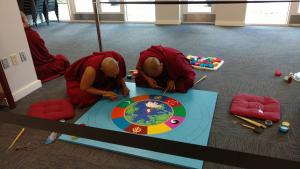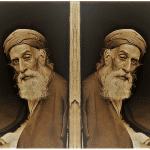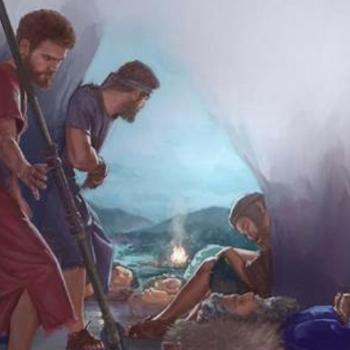As a kid, I spent a lot of time inside museums. My sisters and I grew up outside DC, and on the weekends my dad would take us to the Smithsonian museums so that my mom could get on with the class preparation and grading that went along with being a teacher. It was a great way to spend the weekends. Being kids, we mostly liked the dinosaurs in the Natural History Museum, but we were familiar enough with the other museums to have favorite exhibits – an enormous painting of Daniel in the lion’s den at the National Gallery, the pendulum at the American History Museum, the airplanes hanging from the ceiling in the Air and Space Museum.
The things we learned from museums were sometimes odd. Kids don’t always take in the intended lesson, and I was adept at drawing my own conclusions. In the American History Museum, there is a statue of George Washington portrayed as a Greek god. Wearing only a toga, his gleaming white body is enormous. He seems at least thirteen feet tall, and muscles bulge out from under his marble skin. As a child, I assumed that this was an accurate depiction of our first president. It was in a museum, after all. I took it for granted that Washington was in fact tall, extraordinarily well-built, and liked to sit around in a toga.
When I was twelve, our neighbor took us to the Freer and Sackler Galleries to see Buddhist monks making a sand mandala. Once again, I drew my own conclusions. My take-away from this experience was a sense of futility. I had been told that the practice of constructing a sand mandala ends with destruction. The mandala I was going to see would be swept into a small pile and poured into the Potomac River once it was completed. I was told that Buddhists considered this to be a kind of prayer for peace. It was believed that releasing the mandala into the river would release the hope of peace into the world.
When I saw the mandala, I was amazed by its beauty. Under the warm spotlights of the museum, its colors seemed to glow. I marveled at the careful and deliberate placing of each grain of sand. To me, it seemed that its very construction was art, enacted by figures in red and orange robes – men who possessed apparently limitless patience. I did not understand how they could take so much time over something so beautiful only to destroy it. Surely they would love it too much to let it go.
Obviously my twelve year old self didn’t know much about Buddhism and its teachings on detachment.
A few days after seeing the monks working on the mandala, I noticed a short article in the paper about how the mandala had been released into the river. The grains of sand had swirled downstream. The performance was over. The artwork was gone. Its destruction was complete. I did not think I would see such a thing again, and I wasn’t sure that I wanted to. The whole thing had felt like an exercise in waste. An exercise in loss.
What I didn’t realize at the time was that this trip to the Sackler was going to be a prelude to a period of loss. The changes and shifts of adolescence that inevitably change our identities were already on the horizon. The familiar patterns of childhood were going to give way to changes I did not expect and did not particularly want. The beautiful things we love are not always things we get to keep.
Watching Buddhist monks make a sand mandala was not an experience I had expected to repeat, but recently, visiting monks constructed (and destroyed) a sand mandala at a nearby university. This time, I was the grown-up, taking children to marvel at the patient process involved in making something beautiful.
As an adult, the detachment involved in constructing a mandala was less mystifying to me, but I recognized that I had come back to a familiar moment. This mandala was being constructed less than two months after the Pennsylvania Grand Jury Report. Some cycle had brought me back to a moment when I had struggled with the thought of letting go of something beautiful.
The mandala does not only signify detachment. It is also meant to serve as a symbol for the cosmos, and for ourselves. In Buddhist traditions, the mind is a microcosm of the cosmos (an idea that is echoed by Christian writers such as Hildegard von Bingen). The mandala therefore represents both the universe and our own selves, the macrocosm and the microcosm. To make a mandala (or to observe its making) is to temporarily stand outside the cosmos and our own selves. We adopt a stance from which we try to contemplate the universe and ourselves from the outside, instead of the inside.
This has been my unintentional stance towards Catholicism for several months now. The revelations of the Grand Jury Report pushed me outside my faith. Where I had previously been inclined to focus on the positive aspects of Catholicism, I was now unable to turn away from the the negative. For the first time, perhaps, I was looking at the whole. What I had believed were regional problems, I was seeing as systemic problems. I was (and am) unable to reconcile the image of wise, kindly John Paul II with reports that he had actively concealed and protected predators. Benedict XVI’s admonitions not to see the Church as a mere political organization began to ring hollow. I was realizing that casual misogyny, cruelty towards LGBT persons, clericalism, and corruption are continually undermining Catholic teachings that affirm the dignity of all people.
I was acutely aware of feeling like an outsider in my own church as I watched footage of the fire at Notre Dame earlier this week. The fire would have meant something different to me a year ago. I was watching a church burn down, but it was not my church that was burning down. My church had already burnt.
I keep thinking about the mandala, and how we don’t always get to keep the beautiful things we love. My love for Catholicism has rested on certain long-held images of persons, of churches, and of God. These images have been beautiful, but they are not robust enough to bear confrontation with the uglier realities of the Church. I’m still on the outside, in a place where a Buddhist mandala makes more sense to me as a symbol of resurrection than the rebuilding of Notre Dame.
I have wondered if it is still possible for me to see Catholicism as something beautiful when the experience of seeing the whole has involved seeing my images of faith deconstructed. I have been struggling to let go of and shift my understanding of religious identity and realities in such a way that faith is something I can keep.
In returning to the mandala as a moment in which I had once reflected on loss and letting go, there is a kind of restoration at play. I find myself being invited to reflect again on the nature of loss, on reality, and on my relationship to the world I’ve lived in. The mandala is about letting go, but it is also about seeing a thing from the outside, about seeing the whole. It is possible to see a thing from the outside and see something beautiful. It is possible to return to a moment that signifies loss, and unexpectedly find something that resembles belonging.
Image courtesy of the author.













